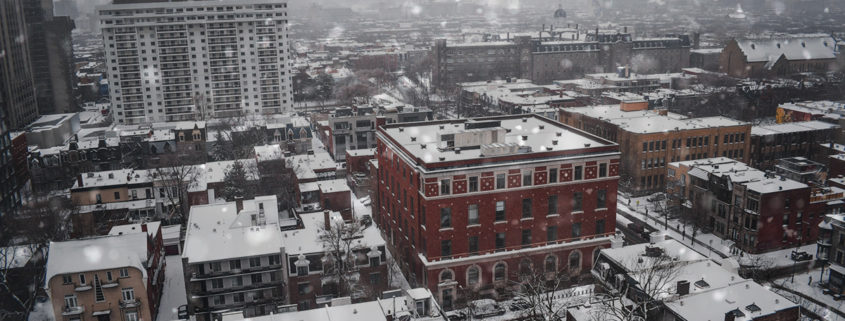Every season forces you to face new and exciting challenges in order to maintain the integrity of your commercial roof, especially winter.
That’s why it’s important to follow the basic steps of winterizing to prevent commercial roof damage. (Winterization protects the roof from deterioration and helps keep your investment intact.)
If you haven’t noticed, weather-resistant roofing is a hot topic, so much so that commercial silicone-based SPF roof coatings saw a 40 percent increase in the latest reports.
Read on to learn more about protecting your business’ roof through the winter months.
Avoid Winter Roof Damage
Replacing a roof costs time and money, and depending on how long construction takes, consumers may be hesitant to visit while work is taking place. These fears can lead to declines in sales and, worse, retention.
Fortunately, keeping your roof in top shape is relatively simple.
Inspect
Before you take any preventative measures, you need to know what shape your roof is in. Ideally, your roof should be inspected twice a year, once before winter and once before summer.
These inspections check for common damages associated with each season and give you a heads-up on areas of concern.
Gutters
Gutters act as the primary defense system of a roof. Without proper drainage, damage can happen quickly. Gutters need to be in good repair and move water off the roof quickly.
Debris caught in gutters impedes water flow, which allows ice to form and increase the weight on the system. Moisture can also build-up and create an opportunity for molds to grow.
Flashing and Caulking
You’ll note that commercial roof configurations vary more widely than residential roofs. This variation coincides with a commercial building’s need for larger HVAC systems and accesses for lights and cables.
A professional commercial roofing team can help keep things in working order, including proper flashing and/or caulking to prevent leaks. Once water starts to infiltrate, it pushes apart these important seals and can create visible leaks within the building.
With the significant amount of overhead electrical and ductwork in commercial buildings, this type of internal damage can wreak havoc.
Snow Accrual
The biggest problem with winter is the snow. Snow by itself is bad enough, but it has a nasty habit of transforming into ice and water (two things you don’t want on your roof).
Heavy snow can add a significant amount of weight to your roof. Worse, the cold encapsulates the building, causing you to turn up the heat (which not only increases utility costs but also results in temperature variation across the surface).
A temperature variant creates condensation inside the roof and a water layer under the ice above, which is how ice dams form. The ice dams formed by the melting and freezing cycle, quickly clog the drainage systems and can form icicles or send water into unprotected spaces.
Keep snow accrual calculations in mind in order to minimize the time snow sits and to know if you are in a danger zone. Ice dam removal is best dealt with immediately on sloped roofs and before secondary storms on flat roofs.
Wind Damage
Wind damage takes its toll on roofing systems. While it is less direct than snow and water damage, it’s still important to address.
Wind creates wear spots in unprotected structures and also carries debris, which can get lodged in drains or wear down flashing.
Missing and damaged pieces of the roof as a result of high wind should be replaced immediately. In general, if you have a concern, you should call an expert to get a quick visual inspection after any severe storm.
Pest Damage
Notable pests for commercial properties include squirrels, rodents and birds. Each of these pests will tear up materials, resulting in water intrusion, and can cause clogs in HVAC systems.
Insects, such as bees and wasps, are also a problem in nooks and crannies. Insects tend to die off or hibernate in winter months, but some will attempt to move into the inner roof for warmth.
Clear up pests with a professional service and then repair any damage caused.
Attic
The area between the sub-ceiling and the roof is an attic. This area contains a lot of different equipment in a commercial building, all of which is vulnerable to water damage.
Ventilation
Condensation in attic ventilation is the biggest danger. Why? Because condensation can freeze and open cracks, creating infiltration points.
Proper insulation helps to combat this problem, but flushing the system periodically is a good way to remove buildup.
Be Prepared
Fighting the negative effects of winter takes effort. However, that effort is minimal when compared to rebuilding or completing major repairs after significant commercial roof damage.
Keep up on maintenance and avoid winter-related issues! Regularly scheduled inspections can easily be completed by a qualified commercial roofing team. They’re fast and painless, too. So, why risk major roofing problems?





